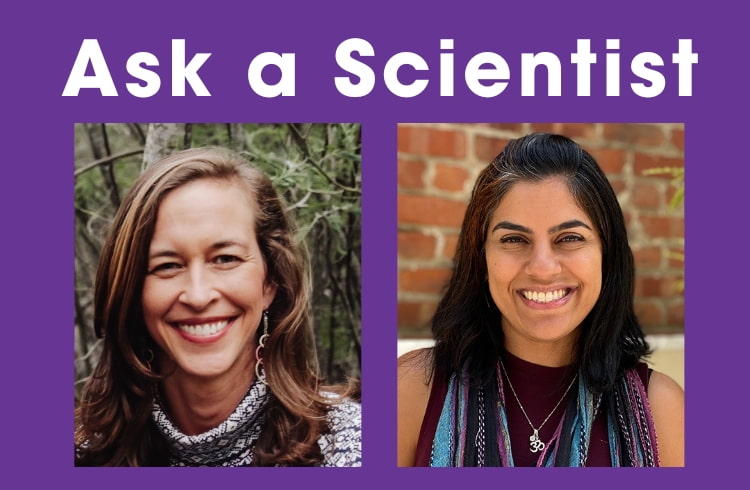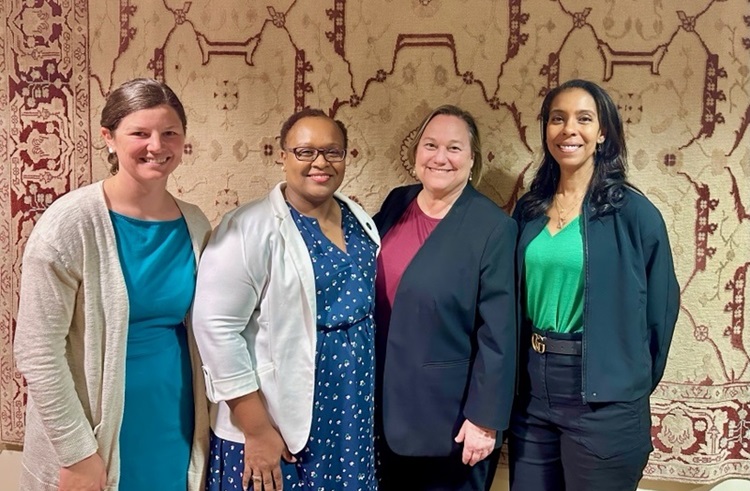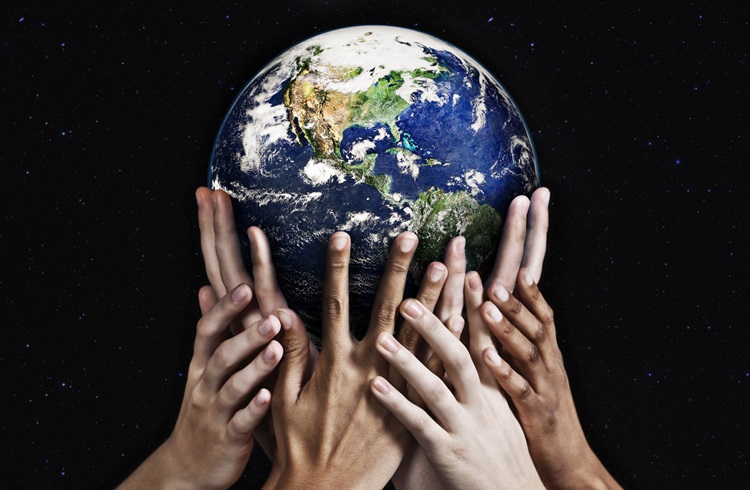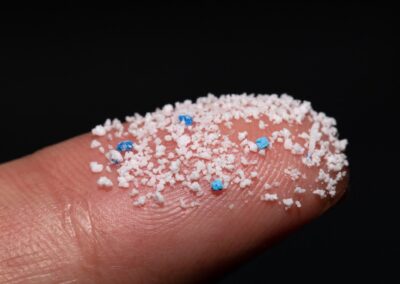Welcome to our series: Ask a Scientist
With BCPP Science Team Dr. Rainbow Rubin, PhD, MPH, and Pujeeta Chowdhary, MPH
The environmental links to breast cancer are complex. Yet, we shouldn’t have to be scientists to understand the health risks we face. At BCPP, our scientists are your scientists, too. We answer your questions with insights from BCPP’s leading science experts.

What does climate change mean to BCPP, and what are we doing about it?
Let’s face it – climate change is a bleak topic. We’ve seen countless statistics and graphs showing rising sea levels and increasing temperatures. We’ve experienced the devastating effects of increasingly common severe weather events. But this month, we’re showcasing the positive strides we are making toward climate change mitigation on every level in our society. And we want your help. Read on to see where you can make a difference with us!
What does climate change have to do with cancer?
The greatest contributor to the environmental impacts of climate change is the combustion of fossil fuels.[1, 2] Fossil fuels also pose a public health threat – from extraction to processing to burning oil and natural gas to produce energy. Every stage involves exposing humans and the environment to potentially hazardous chemicals (such as benzene, dioxins, and polycyclic aromatic hydrocarbons (PAHs)) linked to breast cancer and other cancers.
Fossil fuels are used to power our vehicles and homes, but did you know that the chemical and petrochemical industry is the largest industrial energy consumer worldwide? Not only does this industry account for 18% of the global industrial carbon dioxide emissions, but fossil fuels are used as base ingredients to make many of the cancer-causing chemicals in various consumer products and manufacturing processes.[3] Often, chemical facilities and production operations are located in Black, Latino, and low-income communities.[3] Reducing the production of fossil fuel and hazardous chemicals will not only help reduce carbon dioxide emissions but also improve our air and water and reduce our chemical exposure.
At the same time, our current form of industrial agriculture relies on the intensive use of hazardous chemical fertilizers and pesticides, which significantly contributes to greenhouse gas emissions and potential health issues. In addition, the fossil fuel industry is ramping up plastic production to compensate for the reduction in use in the energy and transportation sectors. And plastics, from start to finish of their lifecycle, contribute to greenhouse gas (GHG) emissions.
As global sea levels rise and temperatures increase, so do the frequency and severity of disasters such as wildfires, droughts, floods, and severe storms, which in turn can increase and exacerbate these chemical exposures. For instance, severe droughts lead to wildfires, which expose people to carcinogens like fine particulates, benzene, and formaldehyde (found in smoke).
Ironically, the chemicals used to extinguish fires, such as per- and poly-fluorinated alkyl substances (PFAS) in firefighting foam and flame retardants, are linked to many adverse health effects, including cancer and endocrine disruption.[4,5]
These severe climate-change-induced disasters can also wreak havoc on healthcare infrastructure and cause interruptions in cancer patients receiving radiation or other treatments, which impact cancer survival rates.[6]
Communities of color and those living in lower-income areas are disproportionately at a higher risk of experiencing impacts from these disasters and access to medical care. Black women also have a 42% higher rate of breast cancer mortality than white women.[7] Communities of color and/or those living in lower-income areas are disproportionately at a higher risk of experiencing impacts from these disasters and access to medical care.
It’s a vicious cycle that we must stop.

Change the System to Change the Climate
BCPP works to create systemic change to strengthen chemical regulation to reduce, if not eliminate, the chemical sector’s use of fossil fuels and its contribution to climate change. We support a variety of bills and policy changes to reduce air pollution at the state and federal levels. Sign our petition for telecom companies to switch from fossil fuels to clean energy!
We’ve also co-sponsored California legislation to eliminate PVC plastics and harmful additives in plastic packaging, advocating for the regulation of fragrance in consumer products, and opposing rollback pressure on clean air regulations.
Under the Biden Administration, the EPA has proposed new federal vehicle emission standards that will continue to reduce CO2 emissions, improve air quality, and accelerate electric vehicle technologies and production. This plan prioritizes and invests in underserved communities that often experience higher levels of pollution.[8]
Climate Change Awareness in Our Community
In 2022, BCPP joined many organizations in supporting a California budget request for community renewable energy plus storage projects owned or subscribed to by low-income households and service organizations.

Climate Change in YOUR House - What can YOU do?
- Calculate your carbon footprint in just 5 minutes using Carbon Hero: https://climatehero.me/ Think of it as a proxy for your toxic chemical footprint.
- Reduce your own transportation carbon footprint! Walk, bike, or use public transportation if possible. Ask your utility company about powering your home with renewable energy.
- Try adding more plants to your diet – not only will you potentially reduce your risk for breast cancer or other health outcomes, but studies show plant-based diets reduce greenhouse gas emissions.[8] Check out these other resources for more information on climate change and food:
- Take this quiz to find out how your diet is linked to climate change, and check out this article for more information.
- Sign up for one of the many apps that allow customers to buy leftover food from restaurants and grocery stores at reduced prices.
- Try climate-friendly ingredients like kelp (and even bugs), or explore cuisines that are gentler on the planet.
- Embrace this simple truth: You don’t need to become vegan to reduce your meat and dairy intake.
- Once you are done feasting, don’t forget about what’s left behind. These tips will help you reduce food waste and repurpose leftovers creatively.
- Take advantage of local produce/foods at your farmer’s market or other local vendors to reduce the carbon footprint of your food – the miles your food traveled to get to your home, as well as reduce the plastic packaging of your food. Major grocery stores and supermarket chains typically obtain produce transported from throughout the country and even far away countries!
- Learn more about products you buy and think about their lifecycle and transportation footprint. Some tips:
- Buy locally-made products where possible or second-hand products available in your region. Join groups that engage in product re-circulation and reuse, like clothes and toy swaps.
- Reduce your use of plastics, which are made from fossil fuels. Buy bulk amounts to cut out lots of small plastic containers. Check out the refill options available near you.
- Where possible, buy, use, share, and donate products made from natural materials with zero or minimal chemical inputs or treatments and products that have a long life span and really offer value for money.
- Support local brick-and-mortar stores. Dial down your Amazon Prime shopping, which promises you speedy delivery at the expense of the environment.
- Check out the Climate Mapping tool to help you understand your local exposure to climate-related hazards so you can be prepared.
- Build an emergency kit to prepare for disasters, and learn more about what to do before, during, and after a disaster.


BCPP Program & Policy team members Janet Nudelman and Laura Gillan with California Assemblymember Lori Wilson and partner California Black Health Network Fresnius Kabi working to pass the Toxic Free Medical Act of 2024 in Sacramento
Staff Spotlights – Our staff is dedicated to improving health and preventing breast cancer by fighting climate change! Read on to see how!
Janet: Making little changes in my kid’s daily routine helps her become more aware of the consequences of climate change and what she can do to make a difference. Lilly refuses plastic straws and brings – or uses – stainless steel or paper straws instead. We choose re-useable lunch bags, thermoses, and stainless-steel water bottles and food containers – instead of plastic! Also, in our 100-year-old house, it’s not easy, but we turn down (or off) the thermostat and grab a sweater or blanket instead!
Lisette: As a consumer, I try to buy second-hand or share and swap as much as possible. I learned this from my parents, who did it to save money. But it’s also a great way to reduce my toxics/climate footprint.
When buying new, I find and buy the more durable non-plastic items: from brooms or dishwashing brushes with metal or wooden handles and natural bristles to food storage containers made from glass or stainless steel. I find a lot at garage sales or my local Goodwill store. We also have an ample collection of reusable picnicware and food thermoses or tiffin tins, clean and ready in the kitchen, and pre-filled re-useable water bottles near the front door, ready to grab and go.
I get a lot of my family’s clothing and household textiles second-hand (also online at like ThredUp and Poshmark) and stay away from synthetic fibers where I can. I also use vinegar, soap, and water for most household cleaning.
Rainbow: I have a background in food systems and am passionate about addressing climate through our diet. Most people are surprised to learn that greenhouse gas emissions from animal agriculture are on par with transportation sector emissions. Reducing meat and dairy consumption is an especially effective approach to climate change because it reduces methane emissions. Methane is a more potent greenhouse gas (causes more warming) than carbon dioxide, although it has a shorter residence time in our atmosphere. (Carbon dioxide is less harmful but tends to stay in our atmosphere for years after it is emitted.) This means that lowering methane gas emissions is one of the most effective and fastest ways to address climate change, and everyone can do it three times a day during mealtimes. Cutting back on animal foods has the added bonus of reducing the risk of cardiovascular disease, diabetes, and, you guessed it, cancer. I conducted a study showing that exposures to carcinogenic food contaminants are highest in meat and dairy because harmful contaminants are often fat-soluble and accumulate at the top of the food chain.
Laura: One way my household has adopted an eco-friendly practice is by switching from paper towels to reusable kitchen towels. We were surprised at how easy this transition was for us. Then when we started having children, we chose to use both cloth and compostable diapers. We also found many of our children’s items (highchair, crib, clothes, toys) through the secondhand market. This not only helped us minimize our environmental footprint but also helped us to connect with other parents and pay it forward to new parents in need.

Recommended Watching:
- Kiss the Ground
- Before the Flood
- Cowspiracy
- What the Health?
- An Inconvenient Truth
- The Story of Stuff
Key Terms:
Climate change – Long-term changes in weather patterns and temperature. Since the industrial revolution, the rate of global greenhouse gas emissions has increased significantly, contributing to the increase in the Earth’s average surface temperature.
Combustion – In terms of fossil fuels, combustion refers to the process of burning coal, oil, and natural gas to produce energy.
Fossil Fuels – Found under the Earth’s crust, fossil fuels include oil, natural gas, and coal, naturally formed over millions of years from decomposing plants and animals.
Greenhouse Gases (GHG) – A gas in the Earth’s atmosphere that traps heat, hence the name “greenhouse.” Types of GHGs include carbon dioxide, methane, ozone, and nitrous oxide.
Fine particulates – Tiny particles of air pollutants (solid particles or liquid droplets) that are less than 2.5 micrometers (a human hair is 70 micrometers wide). They can be composed of many different chemicals and are produced from dust, smoke, automobiles/trucks, and other sources. They can be inhaled and linked to health problems, including cancer.
Methane gas – The primary chemical in natural gas, livestock, and other agricultural processes, food decay in landfills emits methane. Methane is also a greenhouse gas.
Support our science and health content
References
[1] https://www.un.org/en/climatechange/science/causes-effects-climate-change#:~:text=Fossil%20fuels%20%E2%80%93%20coal%2C%20oil%20and,of%20all%20carbon%20dioxide%20emissions.
[2] https://www.epa.gov/ghgemissions/sources-greenhouse-gas-emissions
[3] https://comingcleaninc.org/assets/media/images/Louisville%20Charter%20content/plank%201%20policy%20paper.pdf
[4] Bonefeld-Jorgensen, Eva C et al. “Perfluorinated compounds are related to breast cancer risk in Greenlandic Inuit: a case control study.” Environmental Health 10 (2011): 88. doi:10.1186/1476-069X-10-88.
[5] Jensen, Allan Astrup, and Henrik Leffers. “Emerging endocrine disrupters: perfluoroalkylated substances.” International Journal of Andrology 31, 2 (2008): 161-9. doi:10.1111/j.1365-2605.2008.00870.x.
[6] https://jamanetwork.com/journals/jama/fullarticle/2738278
[7] DeSantis CE, Siegel RL, Sauer AG, et al. Cancer statistics for African Americans, 2016: Progress and opportunities in reducing racial disparities: Cancer Statistics for African Americans, 2016. CA Cancer J Clin. 2016;66:290-308.
[8] https://www.epa.gov/newsreleases/biden-harris-administration-proposes-strongest-ever-pollution-standards-cars-and
[9] https://www.nature.com/articles/s43016-021-00431-5?utm_medium=affiliate&utm_source=commission_junction&utm_content=en_textlink&utm_campaign=3_nsn6445_deeplink_PID100109082&CJEVENT=66992ca27ec611ec8293386d0a18050e




